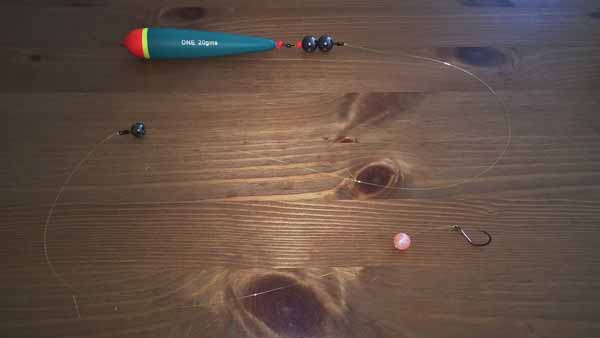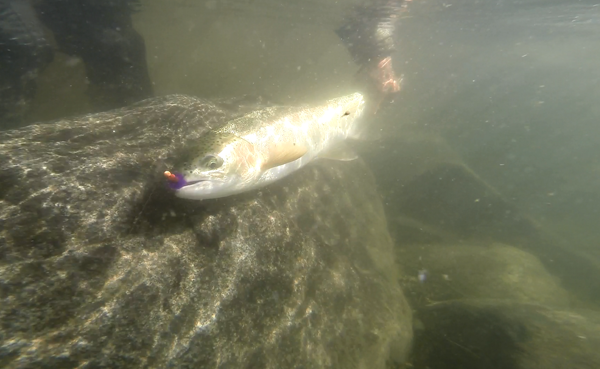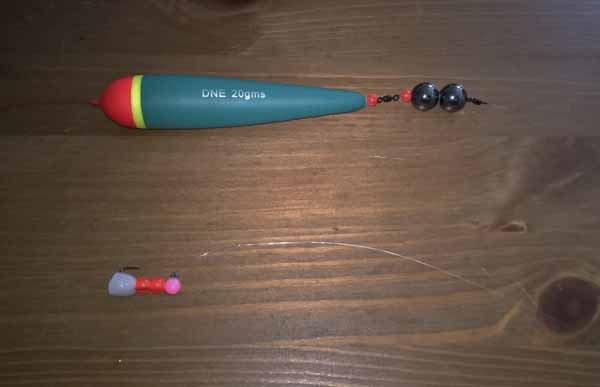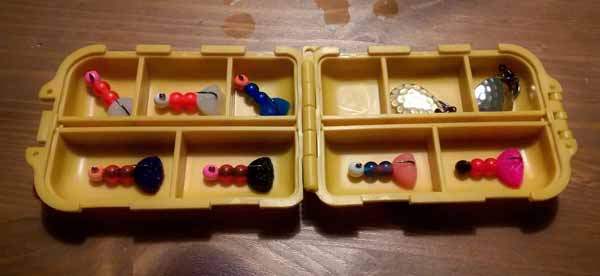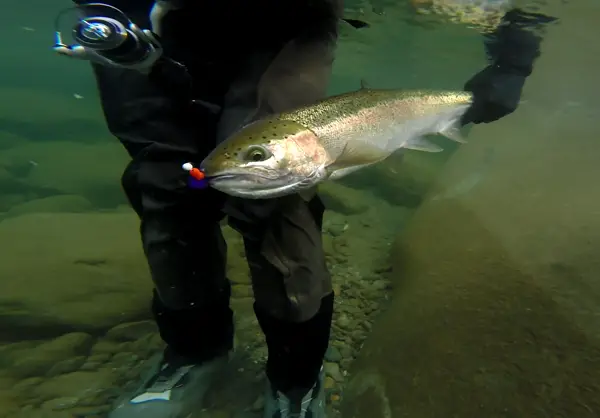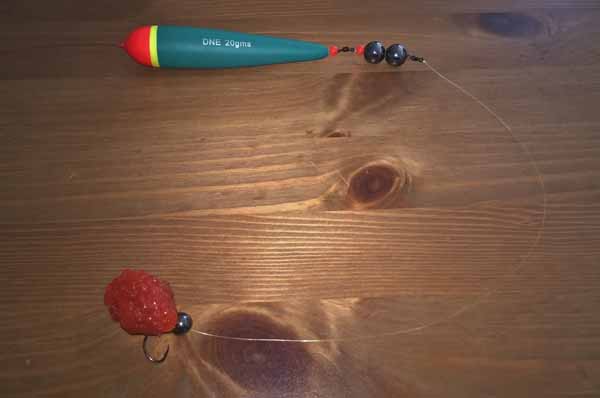Search
Latest Articles
Steelhead Unwilling to Bite?
by Ryan Hung, October 30, 2015

This young hatchery Steelhead was no match for the ploy of this particular Reel Priorities Micro jig.
During its preliminary phase, it was nothing more than purchasing a cork float, suspending bait or Leo Jig beneath it and bellying up to the combat line; success was eminent with little competition in the virgin slots untouched by drift fishermen. Since then, float fishing has evolved--largely thanks to the ingenuity of Canadians--with slip floats ranging in size and color, float fishing weights along with jig and yarn concoctions in every color and material combination possible, each meticulously crafted to evoke subtle bites from the fishermen perusing the aisles . After all, we are much easier to catch than silver-plated olive-backs. With competition increasing, float fishing is no longer a stroll in the park; I'll distill the basics and provide you a few take-aways that will have your float dancing at walking speed and fish snoring on the bank in no time at all.
Like all techniques, we begin with setup. Start by sliding two Beau Mac egg stops onto your main line; the second stop reinforces the first, precluding the ubiquitous "bobber stop slide" many an angler have grown tolerant of. Next, thread on a green 20 gram DNE float--for you Beau Mac fans, the appropriate float size hangs around 3/8ths to 1/2 ounce--followed by a 5 mm plastic bead placed above the appropriate float weight. The sliding bobber stops allow one to adjust depth during fishing, eliminating the need to affix fresh leader material each time and eliminate the need for the more primitive nail knot stops. Now that we have the upper half of float fishing covered, we move to what suspends beneath it.
Next we establish our most important connection to the fish: the leader. Concerning leader material, I never leave home without Maxima Ultragreen--stiff like wire and much stronger than any other brand--or Izorline XXX Copolymer--slightly weaker, boasting limp-feel and abrasion resistant exterior--each in a #6 rating. The light line allows suspended micro-jig offerings to float most naturally in the water, in addition to correcting bad habits during bent-red-warfare that others using heavier lines will never be able to remedy. For example, one using #6 monofilament is forced to play fish properly; it is the crucible for the Steelhead tactician and is an essential component to attaining proficiency in the sport. Think of average fly fisherman playing a larger fish, versus one of commensurate skill fishing gear; I'll put my money on the fly angler due to gear constraints, namely flexible rod and light line. In contrast, utilizing heavier jigs (1/8th and 1/4th ounce) requires heavier line; it does not detract from the natural factor as these jigs weights seldom sway naturally in the water like their smaller counterparts, gaining their rightfully earned title as "bait holders."
Remember how the heavier the leader, the less likely you are too hook up with combat-seasoned hatchery fish when using jigs. Though controversial to some, even with the use of super-duper-clear-can't-catch-fish-without-it-fluorocarbon--a material touted as the most "invisible" on the market--the combination of heavier the line, jig, and shorter the leader length detract greatly from natural appeal. While walking up to hatchery water with a heavy "bait holder" tipped with prawn is a golden ticket--especially after the fish are fresh out of the salt or wide eyed after a relaxing evening--they will not produce consistently all of the time. As the season wanes, water levels dwindle and clarity increases. The remaining fish "get smart;" from here on out, the light-tackled angler will continue to procure bag limits, pulling fish effortlessly from the ordinary. And without covering vast amounts of water, the hardware fisherman is doomed; the game still belongs to the float fisherman armed with the most subtle presentations, secret workhorse being the micro-jig.

An intimate look into my daily jig box. Fresh patterns are prepared each evening prior to fishing, catered to the current water conditions, weather and run at hand.
Fewer offerings exist as innocuous and effective at enticing winter fish than a pink and white jig --maybe even hiding a hint of krystal flash--tipped with raw prawn. Even within the parameters of this particular color combination, many variables exist from materials, weights and shades of pink. For starters, we have two options. Option A involves the use of the 1/8th ounce jig with #8 test leader (or heavier) working the inside seams and frog-water, jig suspended 1'-2' off of the bottom. The majority of steelheaders will obtain their limits in this manner, due in part to the majority following this exact framework. Option B is to trade leader strength for lighter jig and more natural presentation, paying mind to increase the leader length to 1.5 - 2 times the depth of the slot when jigs size decreases to less than 1/16th of an ounce; if depth is adjusted correctly one will seldom lose jigs. With the cycling of colors, one utilizing 1/16th-1/32nd ounce offerings will always out fish the heavier jigs, especially in heavily pounded water. Increased leader length allows the jig to bounce along the bottom, presenting naturally in the closest proximity lethargic winter fish. Think mini oreo rolling down the dinner table, versus cake sitting in front of you; though both are equally desired, chances are if one little hand doesn't snatch the delectable by the time it rolls off, you have probably have defective children. Finally, remember to present your jig higher up in the water column at first light--irrespective of weight--in plain sight of the groggy morning fish; assuming they're not spooked, they'll come up to grab it, especially if it's glowing (hint, hint). More often than not, morning fish are sitting 5 feet in front of you, making them nearly impossible to present properly to without a shorter leader. As the morning wanes, increase your depth accordingly. Though micro-jigs are effective in winter, there is another technique that allows even the most "green" anglers a guaranteed, crescent-shaped-bow in their rod.

The Standard float fishing setup with a 1/32nd ounce jig attached. Add shrimp for bag limit.
Known to many as "bobber dogging" or "float drifting," this technique is responsible for the largest quantity of steelhead napping on winter banks. To setup, one must simply increase their depth by fashioning the two bobber stops an additional 2' above their float. Underneath, it is common to use a standard drift setup with 2' of leader tied from hook to weight, an additional 2 feet affixed from weight to float weight.
Rolling eggs, sand shrimp or raw prawn down the river bottom is hands down the most effective way to entice winter fish. I have yet to awaken on the combat line to the sight of a jig fisherman--not you John from Ted's, you don't count--out-fishing one dogging the bottom with well-prepared bait. Not only does this technique require less skill as the float gently pulls the offering along the bottom, but also saves the angler from many snags unavoidable with drift fishing, thus opening up newfound paths to success for the amateur angler. One needn't worry about proper line mends, depth ascertainment nor the purchase of many frivilous jig patterns, most which will be donated to the river God, due to inexperience. Irrespective of efficacy, no technique will produce fish without first being first placed where fish are holding.

Undeniably the most effective bait for winter steelhead. Standard bait setup with free-sliding 1/8th ounce hematite weight above the roe.
Now that you have a a new tools to decimate future runs of fish, we'll talk about the marachino cherry of fishing: product placement. When venturing to new water, the most efficient way of map out the river bottom is with bobber dogging. Watch your float carefully and note particular "nods of the float" or the lack thereof, to ascertain slot depths and gain a feeling of what peppers the river bottom. Once the slots are discovered, standard procedure applies. At first light, pound the inside seams and 2' frog water with 18" leaders and smaller offerings; if you're serious about getting into some fish, simply add bait. It will be tempting to lengthen up and work the usual haunts, but refraining for the first hour will increase your hook-up-to-outing ratio, ten-fold. Work the water systematically, placing 5 walking-speed drifts through each particular section of holding water; if nothing obliges the invitation, switch offerings and repeat. Remember as with jig colors, alternating scents of bait will oftentimes draw the line between fish on the bank or getting skunked. Like personal finance, there is no greater friend than diversification. Choose to diversify with your offerings in this sport and success should follow. And when all else fails, you'll know how to keep the bite red hot by reading next month's article: How to Circumvent Stubborn-to-bite Steelhead.
Reel Priorities, out.

Few summer steelhead have been able to dodge the silent song of this particular pattern on the Skykomish River.
